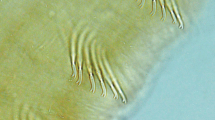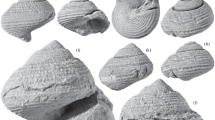Abstract
During a 1987–88 extensive limnological study of Spanish reservoirs, euplanktonic cladocerans were sampled all around the country. Two species of Diaphanosoma Fischer, 1850 were recorded, viz D. mongolianum Uéno, 1938 and D. brachyurum (Liévin, 1848). Morphological descriptions of both species are presented, especially of the thoracic limbs, together with notes on their ecology. Both species present a clear allopatric distribution, D. brachyurum inhabiting waters with a low Total Dissolved Salt (TDS) content, which equilibrated relative ionic composition, characteristic of a narrow strip in the northern part of the Iberian Peninsula; on the contrary, D. mongolianum inhabits waters with high TDS values and high content of sulphate or chloride, characteristic of the central and southern regions.
Similar content being viewed by others
References
Alonso, M., 1985. Las lagunas de la España peninsular: taxonomía, ecología y distribucion de los Cladóceros. Tesis doctoral. Univ. Barcelona. 795 pp.
Armengol, J., 1978. Los crustáceos del plancton de los embalses españoles. Oecol. aquat. 3: 3–96.
Armengol, J., J. L. Riera & J. A. Morgui, 1989. Major ionic composition in the Spanish reservoirs. Verb. int. Ver. Limnol. 24, in press.
Cruz, L., 1981. Estudio de la comunidad zooplanctónica de un lago de alta montaña. Tesis Doctoral. Univ. Granada. 180 pp.
Dirección General de Obras Hidráulicas, 1973. Inventario de presas españolas. Ministerio de Obras Públicas, Servicio de Publicaciones, Madrid. 393 pp.
Kořinek, V., 1981. Diaphanosoma birgei n. sp. (Crustacea, Cladocera). A new species from America and its widely distributed subspecies Diaphanosoma birgei ssp. lacustris n. ssp. Can. J. Zool. 59: 1115–1121.
Kořinek, V., 1984. Cladocera. In J. J. Symoens (ed.), Hydrobiological survey of the Lake Bangweulu Luapula River Basin. Bruxelles, Belgium: 1–107.
Kořinek, V., 1987. Revision of three species of the genus Diaphanosoma Fischer, 1850. Hydrobiologia 145: 35–45.
Korovchinsky, N. M., 1978. Izmenchivost Sida cristallina i Diaphanosoma cf. brachyurum (Crustaces, Cladocera) ozera Glubokogo. Zoologichesky J. 57: 1330–1341.
Korovchinsky, N. M., 1987. A study of Diaphanosoma species of the ‘mongohanum’ group. Int. Revue ges. Hydrobiol. 72: 727–758.
Margalef, R., 1953. Los crustáceos de las agaus continentales ibéricas. Biología de las aguas continentales, 10. Minist. Agricultura, Inst. Forest. Invest. y Exper., Madrid. 243 pp.
Margalef, R., 1983. Limnología. Editorial Omega, Barcelona. 1010 pp.
Miracle, M. R., 1976. Distribución en el espacio y en el tiempo de las especies del zooplancton del lago de Banyoles. Monografías del Instituto Nacional para la Conservación de la Naturaleza 5. 270 pp.
Miracle, M. R., 1978.Composición especifica de las comunidades zooplanctónicas de 153 lagos de los Pirineos y su interés biogeográfco. Oecol. aquat. 3: 167–192.
Toja, J., 1981. Zooplancton de los embalses de Aracena y la Minilla durante 1977. In N. Prat (ed.), Actas del primer congreso español de Limnologia: 105–114. Barcelona.
Author information
Authors and Affiliations
Rights and permissions
About this article
Cite this article
Jaume, D. The genus Diaphanosoma (Ctenopoda: Sididae) in Spain. Hydrobiologia 225, 23–35 (1991). https://doi.org/10.1007/BF00028382
Issue Date:
DOI: https://doi.org/10.1007/BF00028382




